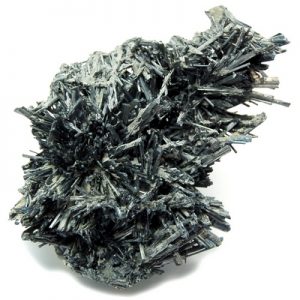Stibnite
Stibnite is the most important ore of antimony. It is an opaque, metallic mineral that forms fine crystal clusters with long straight or curved individual crystals growing out in many divergent directions. The curving of some of the long bladed crystals is due to twinning where one twin plane bends the crystal one direction and another twin plane bends it in the other direction. This can occur many times down the length of one crystal. Stibnite is an unusual gem with bright metallic facets. It is difficult to facet due to its softness and perfect and easy cleavage.
The following localities have produced outstanding crystallized material. In the USA, at the White Caps mine, Manhattan district, Nye County, and the Murray mine, Independence Mountains district, Elko County, Nevada. From the San José and other mines, Oruro, Bolivia. In Germany, at Wolfsburg, Harz Mountains, and near Arnsberg, North Rhine-Westphalia. At Kremnica (Kremnitz) and Banská Štiavnica (Schemnitz), Slovakia. From Príbram, Czech Republic. At Baia Sprie (Felsöbánya) and Herja (Kisbánya), Baia Mare (Nagybánya) district, Romania. In France, at Massaic, Cantal; and at La Lucette, Mayenne. At the Kusa mine, near Bau, Sarawak, Malaysia. From Thames, New Zealand. At Bahar-Lou, near Hamadan, Iran. From Kadamzhay, Kyrgyzstan. Magnificent groups of crystals in the Ichinokawa mine, near Saijo, Ehime Prefecture (Iyo Province), Japan. In China, from the Xikuangshan mine, northeast of Lengshuijiang, Hunan Province and the Lijai Valligy mine, Lushi, Henan Province.
| Category: | Sulfide mineral |
| Chemical Formula: | Sb2S3 |
| Antimony Sulfide | |
| Molecular Weight: | 339.70 gm |
| Composition: | Antimony | 71.68 % | Sb | ||
| Sulfur | 28.32 % | S | |||
| 100.00 % |
| Crystallography: | Orthorhombic – Dipyramidal |
| Crystal Habit: | Slender to stout, complexly terminated crystals, elongated along [001], to 0.65 m; bent crystals not uncommon, rarely twisted. In radiating and confused groups of acicular crystals; also columnar, granular, or very fine masses. |
| Twinning: | Rare; twin planes {130}, {120}, and perhaps {310} |
| Color: | Lead-Gray, tarnishing Blackish or Iridescent; in polished section, White |
| Transparency: | Opaque |
| Luster: | Metallic, splendent on cleavage surfaces |
| Refractive Index: | R1–R2: (400) 31.1–53,3, (420) 30.8–53.2, (440) 30.6–53.0, (460) 30.7–52.8, (480) 31.0–52.2, (500) 31.2–51.1, (520) 31.4–49.7, (540) 31.2–48.5, (560) 30.8–47.2, (580) 30.3–45.8, (600) 29.7–44.5, (620) 29.3–43.5, (640) 29.2–42.6, (660) 29.4–41.8, (680) 29.6–41.1, (700) 29.4–40.3 |
| Birefringence: | 0.00 |
| Anisotrophism: | Strong; Color in reflected light: White |


